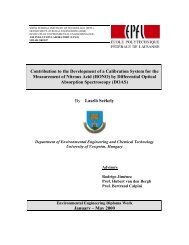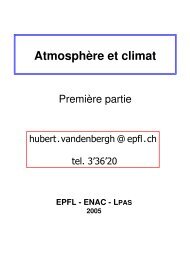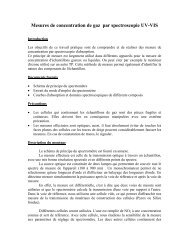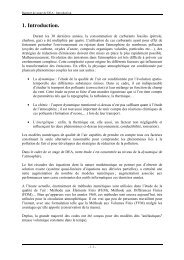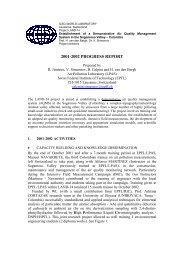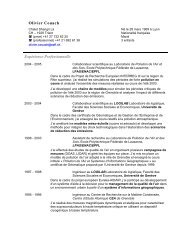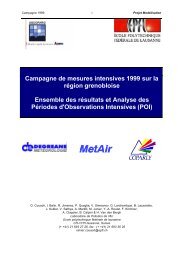Diploma report Implementation and verification of a simple ... - LPAS
Diploma report Implementation and verification of a simple ... - LPAS
Diploma report Implementation and verification of a simple ... - LPAS
Create successful ePaper yourself
Turn your PDF publications into a flip-book with our unique Google optimized e-Paper software.
where Z 0 = Z 0 (z) = ρ 0 (z)c 0 (z) is the impedance <strong>of</strong> the medium. This equation might provide<br />
an explanation for the difference in size between the two peaks. Calculations <strong>of</strong> p ′low <strong>and</strong> p ′up<br />
are made using the values <strong>of</strong> w ′ , ρ 0 <strong>and</strong> c 0 in Table 1 <strong>and</strong> give 196.7960 Pa <strong>and</strong> 141.6410 Pa<br />
for the lower <strong>and</strong> upper wave respectively. These values are close to the values <strong>of</strong> p ′ obtained<br />
in the simulation that figures in Table 1.<br />
As second test case, a top hat perturbation with half width <strong>of</strong> 800 m is initialised in<br />
the middle <strong>of</strong> the domain. This shape <strong>of</strong> perturbation is generally more difficult to simulate<br />
than a Gaussian shape as it features steep slopes. In this case, oscillations generally appear<br />
near the bottom <strong>and</strong> the top <strong>of</strong> these steep slopes. The background state <strong>and</strong> the integration<br />
method are the same than in the previous example.<br />
400<br />
t=0s<br />
300<br />
t=9s<br />
350<br />
250<br />
300<br />
200<br />
250<br />
150<br />
p’[Pa]<br />
200<br />
150<br />
p’[Pa]<br />
100<br />
100<br />
50<br />
50<br />
0<br />
0<br />
0 2500 5000 7500 10000 12500 15000<br />
z[m]<br />
−50<br />
0 2500 5000 7500 10000 12500 15000<br />
z[m]<br />
300<br />
t=18s<br />
250<br />
t=33s<br />
250<br />
200<br />
200<br />
150<br />
150<br />
p’[Pa]<br />
100<br />
p’[Pa]<br />
100<br />
50<br />
50<br />
0<br />
0<br />
−50<br />
0 2500 5000 7500 10000 12500 15000<br />
z[m]<br />
−50<br />
0 2500 5000 7500 10000 12500 15000<br />
z[m]<br />
Figure 8: Evolution <strong>of</strong> a top hat shaped pressure perturbation with 12.5 m resolution.<br />
Only a single simulation with 12.5 m resolution is presented here as an illustration. The<br />
evolution <strong>of</strong> the perturbation is shown in Figure 8. As the perturbation is superimposed<br />
onto a stratified background, the top does not appear flat in the first plot in 8. In the plots<br />
for t = 9, 18 <strong>and</strong> 33 s, the above mentioned oscillations can be observed <strong>and</strong> are relatively<br />
pronounced. The different amplitudes <strong>and</strong> propagation speeds <strong>of</strong> the two waves are analogous<br />
with the previous case. Finally, in the plot for t = 33 s the slope at the top <strong>of</strong> the perturbation<br />
is inverted due to the reflection at the boundary.<br />
Further tests with various values <strong>of</strong> filter coefficient should be performed in order to<br />
attempt to reduce the oscillations. Besides this, simulations with higher grid resolutions<br />
should be done as they might provide better results.<br />
30



